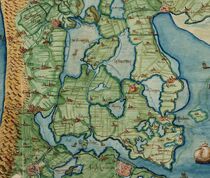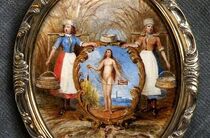No edit summary |
No edit summary |
||
| Line 5: | Line 5: | ||
|imagecaption = The shield of Purmerend depicts the wild woman from the sea. |
|imagecaption = The shield of Purmerend depicts the wild woman from the sea. |
||
|Natural Habitat = Edam, Haarlem, Purmermeer, Zuiderzee}} |
|Natural Habitat = Edam, Haarlem, Purmermeer, Zuiderzee}} |
||
| − | '''De meermin van Edam''' (translation: [[Meermin|Mermaid]] of Edam) was supposedly a wild woman who lived in the [[Zuiderzee]] and was captured by the people of Edam in [[Holland]] who then cleaned her and converted her into their culture after which she started living in the city of Haarlem. She was also referred to as "De meermin van Haarlem", "Zeewijf", "Watervrouwe", "Groennewijf" and her supposed calling name "Minne"<ref>https://www.oud-edam.nl/historie/zeemeermin/</ref>. The wild claims of an actual mermaid living among the people seems too extraordinary to believe today but the people of its time took it for truth. After all, it was the renowned historian Joannes Gerbrandis a Leydis who first wrote the story, claiming he had "reliable sources"<ref>http://www.verhalenbank.nl/items/show/51267</ref>. |
+ | '''De meermin van Edam''' (translation: [[Meermin|Mermaid]] of Edam) was supposedly a wild woman who lived in the [[Zuiderzee]] and was captured by the people of Edam in [[Holland]] who then cleaned her and converted her into their culture after which she started living in the city of Haarlem. She was also referred to as "De meermin van Haarlem", "Zeewijf", "Watervrouwe", "Groennewijf" and her supposed calling name "Minne"<ref>https://www.oud-edam.nl/historie/zeemeermin/</ref>. The wild claims of an actual mermaid living among the people seems too extraordinary to believe today but the people of its time took it for truth. After all, it was the renowned historian Joannes Gerbrandis a Leydis who first wrote the story in 1470, claiming he had "reliable sources"<ref>http://www.verhalenbank.nl/items/show/51267</ref>. |
Revision as of 15:33, 19 August 2018
De meermin van Edam (translation: Mermaid of Edam) was supposedly a wild woman who lived in the Zuiderzee and was captured by the people of Edam in Holland who then cleaned her and converted her into their culture after which she started living in the city of Haarlem. She was also referred to as "De meermin van Haarlem", "Zeewijf", "Watervrouwe", "Groennewijf" and her supposed calling name "Minne"[1]. The wild claims of an actual mermaid living among the people seems too extraordinary to believe today but the people of its time took it for truth. After all, it was the renowned historian Joannes Gerbrandis a Leydis who first wrote the story in 1470, claiming he had "reliable sources"[2].
The Story

A map of Edam, the Zuiderzee and Purmermeer from 1573.
It all starts during the heavy storm of 1403.[3] Violent waves destroyed the dykes that were set up to seperate lake Purmermeer from the Zuiderzee[4]. Water came gushing in and brought along with it a mermaid. When the storm calmed down, the dykes were quickly patched and the mermaid became trapped within Purmermeer. The mermaid was often sighted by two milkmaids on their way to milk their cows. At first, both the mermaid and milkmaids were scared and avoidant, but as time went on, they got used to seeing each other. One fateful day, the mermaid got really close to their boats and the milkmaids saw their chance. They pulled the mermaid on board and took her back to Edam. It became apparent that the mermaid did not speak their language. Nevertheless, the people from Edam raised her as a human being. Everyone realized her longing for the sea, and so - despite her incredible ability to adjust - she was well guarded, so she would not escape. Word spread across the area, and people came to visit Edam just so they could witness the so-called "Zeewijf". The powerful city of Haarlem made it known they wanted her to live in their city so Edam presented the woman as a gift. Haarlem gave her a home on the Grote Houtstraat and taught her to use the spinning wheel but she never learned to speak with human beings. During her lifetime she often went to church and had the habit of making a cross. The people in her vicinity were convinced she had an affinity with the christian faith. At the end of her life she was burried a christian, at a cemetery.
Variations of the Story
Through the older stories and imagery it is suspected that the mermaid of Edam - albeit a water creature from the Zuiderzee who got stuck in Purmermeer - had no tail and was captured by two milkmaids. Most storties tell she had green skin and was covered with goo and plants but looked pretty much human otherwise. Haarlem's prowess was the reason Edam could not keep her and that's why she moved there. But the mermaid story of Edam was a popular one and spawned countless other stories over the centuries. Some say it was a fisherman who captured her and they got married. Another story claims that she was captured by 65 men in 14 different boats[5]. Again other stories say Haarlem sent a small army in order to capture her. And then there's people saying she lived in a monastry until her death. Not to even mention that her appearance eventually changed into half a fish. A poem from 1560 by Casparus Wachtendorp describer having sharp teeth[6], and other versions say that she had thorns on her forehead[7].
Imagery in Dutch Cities

De Zeemeermin van Edam
"De Zeemeermin van Edam", a song about the mermaid of Edam by Waterwijs.
Symbolism of the mermaid slipped its way into cities like Purmerend, Edam, and Haarlem. West of where the lake used to be sits Purmerend, which has the mermaid portrayed on their city's shield[8][9][10]. One of the buildings in Haarlem portrays a facade ornament of both a merman and mermaid to honor this piece of history[11]. And several buildings in Edam - among which the glas stained windows of the Sint Nicolaas church - portray imagery of this woman from the sea.
References
- ↑ https://www.oud-edam.nl/historie/zeemeermin/
- ↑ http://www.verhalenbank.nl/items/show/51267
- ↑ Uitgeverij Bert Bakker: Verhalen van Stad en Streek (Sagen en Legenden in Nederland)
- ↑ http://www.kwaad.net/Purmerend-Geschiedenis.html
- ↑ http://www.hetongetemdezeewijf.nl/meerminvanedam.html
- ↑ Casparus Wachtendorp: Oude Hollandsche geschiedenissen (ofte, Corte RYM-KRONYCK Verdeelt in XIIII boecken, Beginnende van de Suntvloet, tot den Iare 1560.) (https://archive.org/stream/ned-kbn-all-00001588-001#page/n174)
- ↑ S. Franke: Sagen en Legenden rond de Zuiderzee
- ↑ http://www.therightproductions.nl/hogeraadvanadel/index.php?id=109&wapen=643
- ↑ http://www.buitenbeeldinbeeld.nl/Purmerend/Waterschapsstenen.htm
- ↑ http://ngw.nl/heraldrywiki/index.php?title=Purmer
- ↑ https://tavernedewaag.nl/
